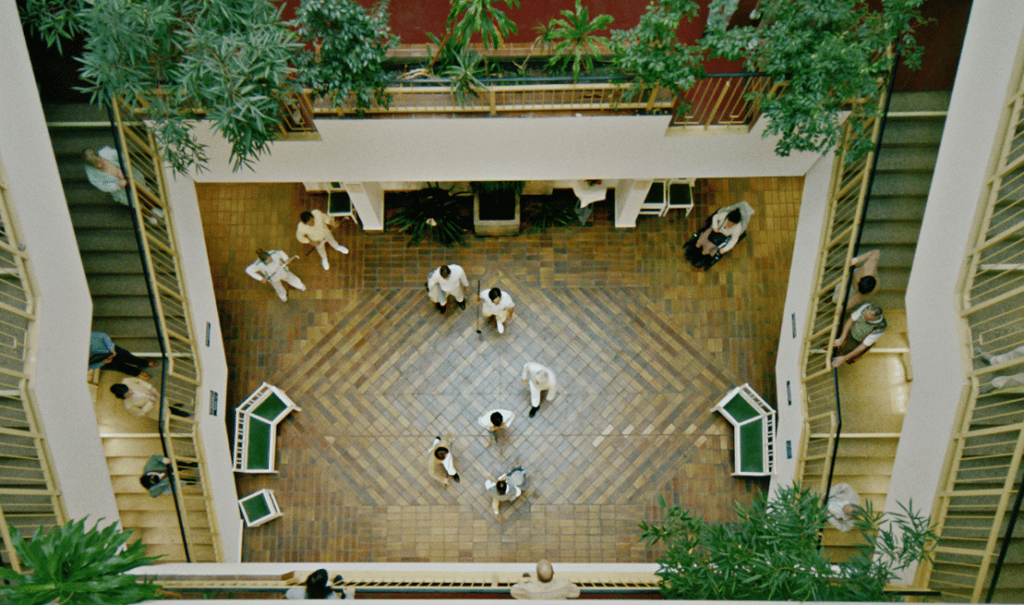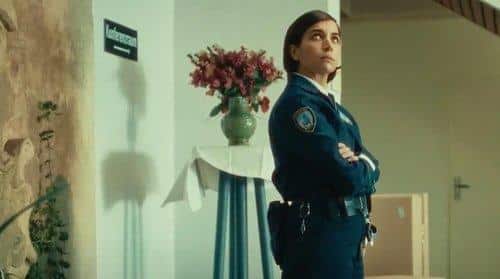
The spectre of the tower block looms appropriately large over modern society. On one hand these blocks are still ‘modern’ and ‘aspirational’, but on the other, they’re seen as unfriendly spaces, whether because degraded, dangerous or just suspiciously separate from other modes of living. Cinema has examined the worst extremes – Land of the Dead (2005), Citadel (2012), Judge Dredd (2012) – but what if we just stick with the idea of the closed community? Of tower blocks as aspirational spaces, designed to keep us safe?
That’s what happens in We Might As Well Be Dead (2022), director Natalia Sinelnikova’s debut feature: here, the most obvious readings and metaphors of the high-rise are replaced by something more shrewd and subtle. The film starts as the camera follows a well-dressed family making their way through woodland before a high-rise appears on its outskirts. They gawp at it: this is clearly their destination. When they get near, we see the building is gated – of course it’s gated – but the gates are opened, allowing them through. At the main entrance, the building’s security officer scans them and asks a number of questions about their health and wellbeing: it’s all part of the application process, it seems. The family begs for clemency: they’re desperate not to be turned back. None of this moves Anna (Ioana Iacob), who has her job to do, that’s all. The committee, which is part of the next stage of the application, takes it all equally seriously.
It’s soon clear that belonging to this highly desirable community of Phoebus House is a meticulous performance; we get this from an actual performance too, a St. Phoebus Day celebration being put on in the building. When someone messes up, interrupting the performance to declare that his dog has escaped, the approbation from the others is matched by a stiff penalty – being made to spend the night outside. Anna, who initially seems a very closed-off individual whose personal life must surely mirror her professional standards, has issues of her own. Her daughter Iris (Pola Geiger) was meant to have performed at the St Phoebus Day show, but refuses at the last minute; she has shut herself in the bathroom, claiming that she’s receiving visions of bad things happening in Phoebus House – this all started, she says, with the dog going missing. Anna tries to be patient, but her concern is that the others will realise Iris isn’t conventionally ‘sick’, but disturbed. That could jeopardise their position; as the entry questions make clear, anyone with undesirable traits may be turfed out.
It doesn’t take much to rattle the residents, either. These people have very little recent experience of living outside the confines of the building, or else they may remember all too well what it’s like, and fear it accordingly. Anna knows this, and tries to head off any more disturbances by looking for the dog herself; it’s at this point that she notices the usually impeccably-behaved inhabitants are beginning to pick away at one another; little by little at first. Then, rumours that an outsider is trying to infiltrate the building seems enough to tip the same inhabitants over the edge. Anna is in an interesting position here: she’s being swept up by the same mounting tension (including within her own family) but it’s her job to try and contain matters, acting as the voice of reason. One of the film’s key lessons for Anna is that her authority is on a knife-edge; if she pleases the others, she’s lauded, and if she doesn’t, she’s sidelined. The shift between the two can happen in minutes. Frightened people are changeable, and that’s key here. But this doesn’t come from the perspective used in other films and stories where people in closed communities act kind, but are really sinister, even cultish; there’s no grand sophisticated conspiracy here, just reactive, skittish people acting absurdly.
But there’s more to it, too: there’s an early visual hint at Anna and Iris’s Polish Jewish heritage and, when push comes to shove, this matters. It takes very little time for the community to begin worrying away at markers of difference, and the family’s Jewishness or, as it’s euphemistically described, their ‘kind’ becomes – or more correctly turns back into – a concern. It’s interesting that a committee member reaffirms her commitment to ‘multiculturalism’ before acting in a way which would suggest the opposite, but so long as the lip service is paid, she seems to feel absolved. Imagine that, eh? Other markers of difference are also used as weapons: for example, length of residence, social morality, status within the building. Through it all – this surprisingly subtle lesson about fractured social cohesion – there runs a thread of very dry, bitter humour. It feels completely appropriate, too, to quietly laugh at some of this weird, irrational, perceived vulnerability: the agony of privilege is as darkly funny as it is exasperating. Again, fittingly, the film looks fantastic throughout. There is lots of low, muted lighting in a building full of mod cons. It has a kind of Ikea-by-night vibe, with a beautiful autumnal world outside – which the residents fear too much to really enjoy.
So what is out there? It almost doesn’t matter; it’s the perception of its terrors which guides all of this irrational behaviour. We Might As Well Be Dead – an intriguing choice of title, come to think of it – emphasises how people rank and persecute one another for reasons which are, ultimately, deeply selfish. It’s a clever, meticulously-made gem.
We Might As Well Be Dead was shown as part of the Fantasia International Film Festival 2022, screening on 19th July.
